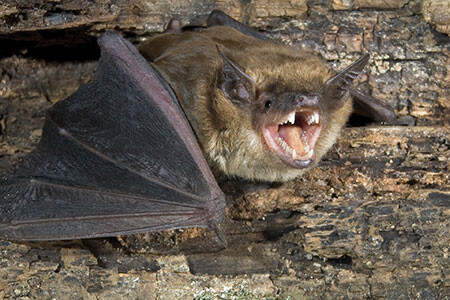 by Susan Himes
by Susan Himes
Texas A&M AgriLife Extension Service specialists and agents are frequently asked about bats. And since the week leading up to Halloween is, appropriately enough, Bat Week, experts from Texas A&M AgriLife and Texas A&M Veterinary Medical Diagnostic Laboratory, TVMDL, have offered explanations as to why bats are more friend than foe.
“The benefit from bats far outweighs the risk to humans,” said Terry Hensley, DVM, TVMDL associate director, Bryan-College Station. “As long as you use common sense around bats, just like any other wildlife, there isn’t much to fear.”
Bats, in fact, play an integral part in the Texas ecosystem. Many are insectivorous, or insect-eaters, saving farmers’ crops from pest damage. Others are nectivorous and serve as pollinators of some types of fruits, cacti and plants with nocturnal flowers.
It is estimated that bats eat enough insects in Texas to save producers over $1.4 billion annually in pest control costs alone. Worldwide estimates range as high as $53 billion saved between preventing crop losses and the reduced need for pesticides annually.
Texas: We’re No. 1 in bats
Texas is home to the largest colony of bats in the world, not to mention having the largest bat population in the U.S.
Between the millions of Mexican free-tailed bats that make Bracken Cave outside of San Antonio their home to the iconic colony of 1.5 million who live under the Congress Avenue Bridge in Austin, many Texans appreciate and accept these mammals.
People’s interest in bats is so great that an online Texas A&M AgriLife Bats 101 course is currently in development. Even the annual AgriLife Extension Birding the Border program includes bat talks, bat excursions and bat-themed events.
But some people still fear these furry flyers, usually for reasons largely unfounded. Even opinions vary on the quarter million bats who inhabited Kyle Field on the Texas A&M campus before the 2015 renovation. Depending on who you talk to, they were either a cool part of campus, a problem or a nightmare in the night sky.
Diseases from bats
“There really are only two main diseases to worry about with bats: rabies and histoplasmosis,” said Maureen Frank, Ph.D., AgriLife Extension wildlife specialist in Uvalde. “If a person is bitten by a bat, wash the bite and go to the doctor immediately.
However, Hensley noted in North America rabies really isn’t a big issue. Studies have shown that less than 1% of the Texas bat population has the disease, which is fatal to bats.
Infected bats typically die quickly of the disease, limiting the amount of time they could pass rabies on to other animals. However, when bats hibernate, so does the disease. A bat who contracted rabies right before hibernation can live with the disease for the entire hibernation period.
Odds are slim a bat, as long as left alone, would bite a person. Dogs, cats, cows and horses are all curious creatures and would probably go inspect a critter flopping around on the ground, which Hensley said is a behavior in a bat that could indicate rabies.
“That is precisely why we give animals rabies vaccines,” he said. “We want to protect our pets, but the vaccines also serve as a protective interface between ourselves and the diseases our pets could get from wildlife.”
Hensley explained that by vaccinating our pets we are also protecting ourselves and our families from zoonotic diseases. He also said a bite from an infected racoon or fox is a far more likely way to transmit rabies than by direct contact with a bat.
Rabies can be transmitted from a bite or scratch from an infected animal. Another way is through the inhalation of aerosolized rabies virus, although that is far less common, Hensley said.
“But that said, that’s a reason why if a bat gets into your house, you want it out as soon as possible,” he explained
Avoid bat feces: Just say ‘no’ to guano
“The reason you don’t want to go into bat caves or empty structures they are roosting in is because of the guano,” Hensley said. “Guano is bat poop, and that is how histoplasmosis is spread.”
Hensley said histoplasmosis is a fungal disease also found in areas where large amounts of bird feces may be present. Avoid environments where you could breathe in these fungal spores that can cause flu-like symptoms.
If you find bats roosting in a barn or attic and must clean up the guano, Frank said, wear personal protective equipment, PPE.
“Your PPE should include gloves, long sleeves, pants and a mask,” she said.
If histoplasmosis spores are inhaled and a person becomes infected, symptoms typically show up in three to 17 days, according to the Centers for Disease Control and Prevention. In severe cases, symptoms may linger for months and result in long-term lung infections.
Beware of bats behaving badly
 Bats really have little to no interest in people. So, just seeing a bat in your yard isn’t reason for concern, said Frank. However, bats are nocturnal, so seeing one in your yard during daylight hours should raise a flag.
Bats really have little to no interest in people. So, just seeing a bat in your yard isn’t reason for concern, said Frank. However, bats are nocturnal, so seeing one in your yard during daylight hours should raise a flag.
If you do see one acting erratically or on the ground, proceed with caution. This is not normal behavior, so the animal could be sick, injured or among the small percentage with rabies.
“Don’t mess with a bat on the ground,” said Hensley. “If it is on the ground, it’s on the ground for a reason. That is not normal behavior. It could have rabies, or it could be a young bat just learning to fly, much like a baby bird learning to leave the nest.”
Hensley said another possibility could be the bat is migrating and taking a rest from traveling. Hensley suggests letting the bat leave on its own, keeping children and pets clear of it in the meantime. However, if the bat is exhibiting erratic behavior, call your local animal control.
If you suspect or see a bat bite a child or pet, it is a good idea to get the bat tested for rabies if you can safely do so. Ideally, you should never handle a bat, especially barehanded.
“Call your local animal control first,” Hensley said. “ If you must remove it though, wear leather gloves and put something like an empty coffee can over the bat on the ground, then slide a piece of paper under the can so you can then turn it over and put on a lid,” Hensley said.
Hensley added that you don’t want to forget to poke holes in the lid so it can breathe, and then call your local vet or animal control to be tested for rabies.
“Even if it has rabies or an injury that it needs to be euthanized for, we want to treat it as humanely as possible,” he said.
Excluding bats and avoiding zoonotic diseases
As human populations grow and encroach on wildlands, more people will come in contact with wildlife and whatever diseases they may carry. Zoonotic diseases are those, like rabies, that can pass between different species.
“We’ve seen other examples of zoonotic diseases in recent years, such as SARS that originated in bats, and COVID-19, which most likely did too,” Hensley said. “But bats aren’t to blame. They don’t want to be around humans, but as we spread into the natural habitats of wildlife, we can expect to see more diseases spreading between mammals.”
You don’t want bats in your belfry, or in any other structure you, or livestock or pets, may reside in for that matter.
Bats can be excluded from buildings by plugging the holes where they are observed coming and going. Don’t close or block any entry points in the summer, however, Frank said, as this is breeding season and young bats may then be trapped inside.
“If a bat does get into your home, you want it out as soon as possible,” Hensley said. “Open a door and windows, and let it get itself out.”
If that doesn’t work, call your local animal control he said.
“Even though the percentage of bats with rabies in North America is quite small, if you do encounter a bat acting weird around your home or yard, you need to keep in mind that rabies is a likely cause .”
For more information about rabies visit the Texas Department of State Health Services Infectious Disease Control website.
Vampire bats
As appropriate as it may seem for a year that has been haunted by COVID-19, murder hornets and a series of natural disasters, experts say vampire bats are not anything to lose sleep over. In fact, they are not even among the 33 species found in Texas.
There are three types of vampire bats whose diet consists only of blood, making them the only mammals that can survive on blood alone. And although they have been known to bite humans, we’re not their meal of choice.
“The vampire bat is not something we need to worry about,” Hensley said. “They are making their way north, but we don’t have to worry about them in the U.S., yet.”
Vampire bats are currently found mostly in South and Central America, although they have reached parts of Mexico. These bats use their fangs to make a puncture wound in animals such as cattle and horses as they sleep, then use their tongues to lap up the blood – a leisurely meal that lasts about half an hour.
As scary as some bats may seem, it’s important to remember that the protection of all bats is critical to agriculture throughout the world. Texas has laws in place to protect bats and worldwide there are currently more than 600 endangered species of bats. A bat rescue or rehabilitation center may also be a helpful resource.





